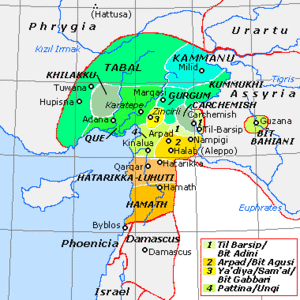Arpad (Old Aramaic: 𐡀𐡓𐡐𐡃, romanized: ʾRPD; Biblical Hebrew: אַרְפַּד, romanized: ʾArpaḏ or אַרְפָּד, ʾArpāḏ;[1] modern Tell Rifaat, Syria) was an ancient Aramaean Syro-Hittite city located in north-western Syria, north of Aleppo. It became the capital of the Aramaean state of Bit Agusi established by Gusi of Yakhan in the 9th century BC.[2] Bit Agusi stretched from the A'zaz area in the north to Hamath in the south.[3]
Arpad later became a major vassal city of the Kingdom of Urartu. In 743 BC, during the Urartu-Assyria War, the Neo-Assyrian king Tiglath-Pileser III laid siege to Arpad following the defeat of the Urartuan army of Sarduri II at Samsat. But the city of Arpad did not surrender easily. It took Tiglath-Pileser three years of siege to conquer Arpad, whereupon he massacred its inhabitants and destroyed the city.[4] Afterward Arpad served as a provincial capital.[5] Tell Rifaat, which is probably the remains of Arpad, has walls still preserved to a height of eight meters.[6]
YouTube Encyclopedic
-
1/3Views:4 258926380
-
How to pronounce Árpád
-
AGE OF EMPIRES Part 3: Voices of Babylon - REAL HISTORY
-
Syria: sign of the imminent return of Jesus!
Transcription
Biblical references
The city is mentioned several times in the Hebrew Bible:
- 2 Kings 18:34; 19:13
- Isaiah 10:9; 36:19; 37:13
- Jeremiah 49:23, within the oracle against Damascus, one of the poetic "oracles against foreign nations" found in the later chapters of the Book of Jeremiah.[7]
The Assyrian vizier, Rabshakeh, lists the god(s) of Arpad among those who he alleges have been unable to save their cities from Assyrian assault.[8]
Etymology
The word Arpad in Hebrew means 'the light of redemption',[9] or 'I shall be spread out (or: supported)'[10]
Archaeology
Tel Rifaat is an oval 250 by 233 meters. Within this, the main citadel is 142 by 142 meters with a maximum height of 30 meters. The defensive wall surrounding the site is about two miles long.
The site has been worked by a team from the Institute of Archaeology or the University of London. After a preliminary examination in 1956, Tell Rifa'at was excavated for two seasons in 1961 and 1964. The team was led by Veronica Seton-Williams.[11][12]
In 1977, an archaeological survey was conducted of the area around Tell Rifa'at, also by the Institute of Archaeology.[13]
See also
Notes
- ^ "BDB, אַרְפַּד 1". www.sefaria.org.
- ^ Lipinsky, Edward (2000). The Aramaeans: Their Ancient History, Culture, Religion. Peeters Publishers. p. 195. ISBN 9789042908598.
- ^ Lipinsky, 2000, p. 99.
- ^ Healy, Mark (1992). The Ancient Assyrians. Osprey. p. 25. ISBN 9781855321632.
- ^ Kipfer, Barbara Ann (2000). Encyclopedic Dictionary of Archaeology. Springer Science & Business Media. p. 626. ISBN 9780306461583.
- ^ Lipinsky, 2000, p. 529.
- ^ Coogan, Michael David; Brettler, Marc Zvi; Newsom, Carol Ann; Perkins, Pheme (2007). The New Oxford Annotated Bible with the Apocryphal/Deuterocanonical Books: New Revised Standard Version, Issue 48. Oxford University Press. ISBN 9780195288810.
- ^ 2 Kings 18:34
- ^ "Arpad Definition and Meaning - Bible Dictionary". Bible Study Tools.
- ^ "NETBible: Arpad". classic.net.bible.org.
- ^ M. V. Seton Williams, Preliminary Report on the Excavations at Tell Rifa'at, Iraq, vol. 23, no. 1, pp. 68-87, 1961
- ^ M. V. Seton Williams, The Excavations at Tell Rifa'at: 1964 Preliminary Report on, Iraq, vol. 29, no. 1, pp. 16-33, 1967
- ^ John Matthers, Tell Rifa'at 1977: Preliminary Report of an Archaeological Survey, Iraq, vol. 40, no. 2, pp. 119-162, 1978
References
- Clayton, Peter A. "The Coins from Tell Rifa'at." Iraq 29, no. 2 (1967): 143-54. Accessed October 18, 2020. doi:10.2307/4199831.
- Millard, Alan R. "Adad-Nirari III, Aram, and Arpad" Palestine Exploration Quarterly, vol. 105 Issue 2 (1973): 161–164. Accessed October 18, 2020. doi:10.1179/peq.1973.105.2.161
36°28′N 37°06′E / 36.47°N 37.10°E


